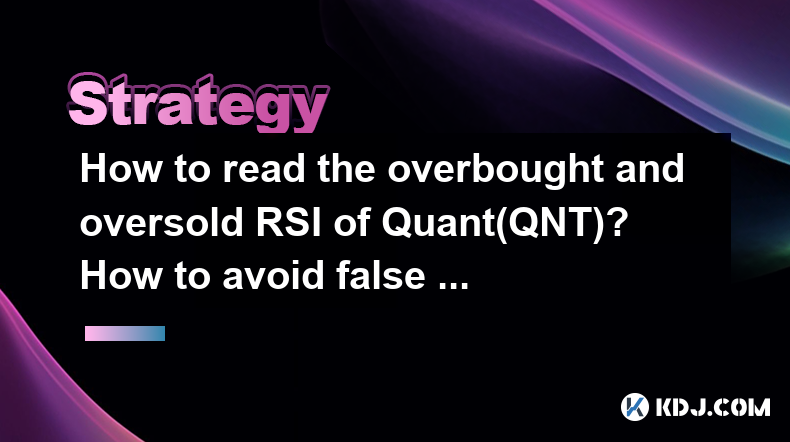-
 bitcoin
bitcoin $110918.433029 USD
-1.69% -
 ethereum
ethereum $3996.872473 USD
-2.43% -
 tether
tether $1.000594 USD
0.00% -
 bnb
bnb $1178.871834 USD
-2.38% -
 xrp
xrp $2.413973 USD
-3.47% -
 solana
solana $194.341461 USD
-4.24% -
 usd-coin
usd-coin $0.999963 USD
-0.03% -
 tron
tron $0.320092 USD
0.92% -
 dogecoin
dogecoin $0.196919 USD
-3.42% -
 cardano
cardano $0.669585 USD
-3.63% -
 hyperliquid
hyperliquid $37.485952 USD
-3.58% -
 ethena-usde
ethena-usde $1.000026 USD
-0.02% -
 chainlink
chainlink $18.018220 USD
-5.13% -
 bitcoin-cash
bitcoin-cash $523.879267 USD
-2.41% -
 stellar
stellar $0.324655 USD
-3.67%
How to read the overbought and oversold RSI of Quant(QNT)? How to avoid false signals?
RSI measures Quant (QNT) price momentum, signaling overbought above 70 and oversold below 30; use with other indicators to avoid false signals and confirm trends.
May 03, 2025 at 02:07 pm

Understanding the RSI Indicator
The Relative Strength Index (RSI) is a momentum oscillator that measures the speed and change of price movements. It is used to identify overbought or oversold conditions in a market, helping traders make informed decisions. The RSI oscillates between 0 and 100, with readings above 70 indicating overbought conditions and readings below 30 suggesting oversold conditions. For the cryptocurrency Quant (QNT), understanding the RSI can be crucial for effective trading.
Reading the RSI for Quant (QNT)
When analyzing the RSI for Quant (QNT), it is important to focus on the following aspects:
- Overbought Conditions: When the RSI value exceeds 70, it suggests that Quant (QNT) may be overbought. This could mean that the price has risen too quickly and might be due for a correction or pullback.
- Oversold Conditions: Conversely, an RSI value below 30 indicates that Quant (QNT) may be oversold. This suggests that the price has fallen too quickly and might be poised for a rebound.
To read the RSI for Quant (QNT), follow these steps:
- Access a Trading Platform: Log into a trading platform that supports Quant (QNT) and provides RSI data.
- Locate the RSI Indicator: Find the RSI indicator on the platform, usually available in the indicators or technical analysis section.
- Analyze the RSI Value: Observe the current RSI value for Quant (QNT). If it is above 70, the asset is considered overbought. If it is below 30, it is considered oversold.
- Monitor Trends: Look at the RSI trend over time to understand whether the asset is moving towards overbought or oversold conditions.
Interpreting RSI Signals for Quant (QNT)
Interpreting RSI signals for Quant (QNT) involves more than just looking at the current value. Consider the following:
- Divergence: Pay attention to divergences between the RSI and the price of Quant (QNT). If the price is making new highs while the RSI is not, it could be a bearish divergence, indicating potential weakness. Conversely, if the price is making new lows while the RSI is not, it could be a bullish divergence, indicating potential strength.
- Failure Swings: Look for failure swings, which occur when the RSI surpasses a previous high or low and then reverses. These can signal potential trend changes.
- Trend Confirmation: Use the RSI to confirm trends. If Quant (QNT) is in an uptrend and the RSI remains above 50, it confirms the strength of the trend. If it is in a downtrend and the RSI remains below 50, it confirms the weakness of the trend.
Avoiding False Signals with Quant (QNT) RSI
False signals are a common issue when using the RSI, but there are strategies to mitigate them:
- Use Additional Indicators: Combine the RSI with other indicators such as Moving Averages, MACD, or Bollinger Bands to confirm signals. For example, if the RSI indicates an overbought condition but the MACD does not show bearish divergence, it might be a false signal.
- Check Volume: Volume can validate RSI signals. If the RSI suggests an oversold condition but the volume is low, the signal might be false. Conversely, high volume during an overbought or oversold condition can confirm the signal.
- Timeframe Analysis: Analyze the RSI across different timeframes. A signal on a shorter timeframe might be a false signal when viewed on a longer timeframe. For instance, an overbought signal on a 15-minute chart might not be significant if the daily chart shows a neutral RSI.
- Wait for Confirmation: Do not act immediately on RSI signals. Wait for price action to confirm the signal. For example, if the RSI indicates an oversold condition, wait for the price of Quant (QNT) to start rising before entering a trade.
Practical Application of RSI for Quant (QNT)
To apply the RSI effectively for Quant (QNT), consider the following practical steps:
- Identify Entry Points: Use the RSI to identify potential entry points. If the RSI indicates an oversold condition and other indicators confirm a potential uptrend, consider entering a long position.
- Set Stop-Losses: Always set stop-losses to manage risk. If you enter a trade based on an RSI signal, set a stop-loss at a level that would invalidate the signal.
- Monitor Exits: Use the RSI to monitor potential exit points. If the RSI moves into overbought territory and other indicators suggest a potential downtrend, consider exiting a long position.
- Backtest Strategies: Before applying RSI strategies to live trading, backtest them using historical data for Quant (QNT). This can help you understand the effectiveness of the RSI in different market conditions.
Adjusting RSI Settings for Quant (QNT)
The default RSI setting is 14 periods, but you can adjust it to suit different trading styles and timeframes. For Quant (QNT), consider the following adjustments:
- Shorter Periods: Using a shorter period, such as 9 periods, can make the RSI more sensitive to price changes. This is useful for short-term trading but can increase the number of false signals.
- Longer Periods: Using a longer period, such as 25 periods, can make the RSI less sensitive to price changes. This is useful for long-term trading but can delay signals.
- Experiment and Adapt: Experiment with different RSI settings and adapt them based on the volatility and trading patterns of Quant (QNT).
FAQs
Q: Can the RSI be used as a standalone indicator for trading Quant (QNT)?A: While the RSI can provide valuable insights into overbought and oversold conditions, it is generally more effective when used in conjunction with other technical indicators. Relying solely on the RSI can lead to false signals and missed opportunities.
Q: How often should I check the RSI for Quant (QNT)?A: The frequency of checking the RSI depends on your trading style. For day traders, checking the RSI multiple times a day can be beneficial. For swing traders, checking it daily or weekly might be sufficient. Always align the frequency with your trading strategy and the timeframe you are analyzing.
Q: Is it possible to use the RSI for Quant (QNT) on different timeframes simultaneously?A: Yes, it is possible and often recommended to use the RSI on multiple timeframes. This can provide a more comprehensive view of the market. For example, you might use the RSI on a 15-minute chart for short-term signals and a daily chart for longer-term trends.
Q: Can the RSI be used to predict price reversals for Quant (QNT)?A: The RSI can indicate potential price reversals by identifying overbought and oversold conditions. However, it is not a foolproof method for predicting reversals. Always use additional analysis and confirmation from other indicators to increase the reliability of your predictions.
Disclaimer:info@kdj.com
The information provided is not trading advice. kdj.com does not assume any responsibility for any investments made based on the information provided in this article. Cryptocurrencies are highly volatile and it is highly recommended that you invest with caution after thorough research!
If you believe that the content used on this website infringes your copyright, please contact us immediately (info@kdj.com) and we will delete it promptly.
- BNB, Coinbase, and Record Highs: What's the Deal?
- 2025-10-16 20:45:17
- Cryptos to $50K: Can $1000 Turn Into a Fortune?
- 2025-10-16 20:45:17
- Alaska Gold Meets 2025 Token Mania: A Wild Ride!
- 2025-10-16 20:50:01
- Pudgy Penguins (PENGU) Rally Close: Will the Penguin Fly or Flop?
- 2025-10-16 20:50:01
- Avalon X: Revolutionizing Real Estate Investing with RWA Presales
- 2025-10-16 20:50:01
- Crypto Under $1 to Watch in 2025: Finding the Next Big Thing
- 2025-10-16 20:50:12
Related knowledge

Practical parameter settings for a Bitcoin multi-timeframe moving average system
Sep 18,2025 at 10:54pm
Optimizing Timeframe Combinations for Bitcoin Trading1. Selecting appropriate timeframes is crucial when building a multi-timeframe moving average sys...

How can I filter out false breakouts in Dogecoin high-frequency trading?
Sep 22,2025 at 01:00am
Understanding False Breakouts in Dogecoin Trading1. A false breakout occurs when Dogecoin's price appears to move beyond a defined support or resistan...

Techniques for identifying tops and bottoms in the Bitcoin on-chain NVT model
Sep 20,2025 at 07:54pm
Understanding the NVT Model in Bitcoin Analysis1. The Network Value to Transactions (NVT) ratio is often described as the 'P/E ratio' of the cryptocur...

What does the surge in open interest in Bitcoincoin futures mean?
Sep 20,2025 at 11:18pm
Understanding the Surge in Dogecoin Futures Open Interest1. A surge in open interest within Dogecoin futures indicates a growing number of active cont...

How can I use the Ethereum USDT premium to gauge market sentiment?
Sep 18,2025 at 11:55pm
Understanding the Ethereum USDT Premium1. The Ethereum USDT premium refers to the price difference between USDT (Tether) traded on Ethereum-based plat...

What should I do if Ethereum staking yields decline?
Sep 20,2025 at 06:18am
Understanding the Causes Behind Declining Ethereum Staking Yields1. The Ethereum network transitioned to a proof-of-stake consensus mechanism with the...

Practical parameter settings for a Bitcoin multi-timeframe moving average system
Sep 18,2025 at 10:54pm
Optimizing Timeframe Combinations for Bitcoin Trading1. Selecting appropriate timeframes is crucial when building a multi-timeframe moving average sys...

How can I filter out false breakouts in Dogecoin high-frequency trading?
Sep 22,2025 at 01:00am
Understanding False Breakouts in Dogecoin Trading1. A false breakout occurs when Dogecoin's price appears to move beyond a defined support or resistan...

Techniques for identifying tops and bottoms in the Bitcoin on-chain NVT model
Sep 20,2025 at 07:54pm
Understanding the NVT Model in Bitcoin Analysis1. The Network Value to Transactions (NVT) ratio is often described as the 'P/E ratio' of the cryptocur...

What does the surge in open interest in Bitcoincoin futures mean?
Sep 20,2025 at 11:18pm
Understanding the Surge in Dogecoin Futures Open Interest1. A surge in open interest within Dogecoin futures indicates a growing number of active cont...

How can I use the Ethereum USDT premium to gauge market sentiment?
Sep 18,2025 at 11:55pm
Understanding the Ethereum USDT Premium1. The Ethereum USDT premium refers to the price difference between USDT (Tether) traded on Ethereum-based plat...

What should I do if Ethereum staking yields decline?
Sep 20,2025 at 06:18am
Understanding the Causes Behind Declining Ethereum Staking Yields1. The Ethereum network transitioned to a proof-of-stake consensus mechanism with the...
See all articles


























![Web3 Crypto Market Morning Report: The market is in decline, altcoins have fallen by more than 5%, Binance compensation has been received, and Memes on the Bnb chain have collectively plummeted [Vic TALK Issue 1444] Web3 Crypto Market Morning Report: The market is in decline, altcoins have fallen by more than 5%, Binance compensation has been received, and Memes on the Bnb chain have collectively plummeted [Vic TALK Issue 1444]](/uploads/2025/10/16/cryptocurrencies-news/videos/web-crypto-market-morning-report-market-decline-altcoins-fallen-binance-compensation-received-memes-bnb-chain-collectively-plummeted-vic-talk-issue/68f043c9c8b44_image_500_375.webp)















































